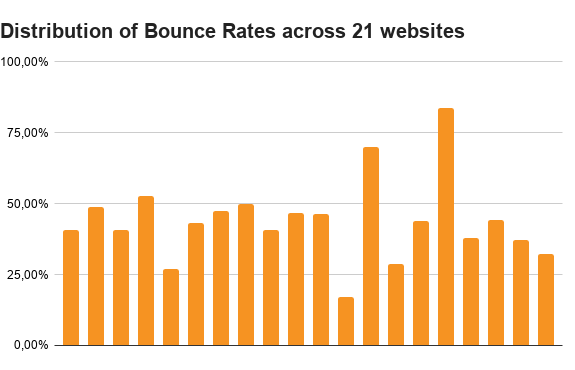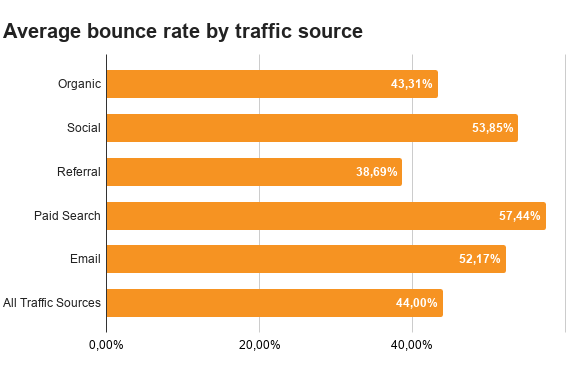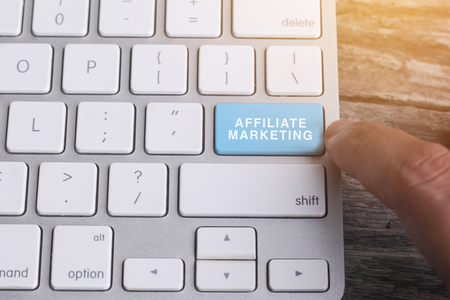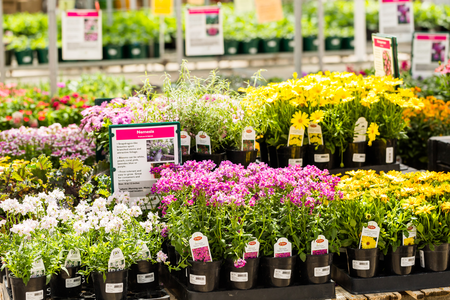Does the ideal bounce rate exist?
Some of the most frequently asked questions by garden centre marketeers when we’re talking about Google Analytics are about the bounce rate. “What’s the best bounce rate” or “What bounce rate do other garden centres have” are common questions asked during meetings.
If you’re not sure what the bounce rate is: people visiting one page on your website and leaving your website straight away, without clicking to another page.
You might want to lower your bounce rate since it means visitors are staying longer on your website. But you can’t get it to 0% and there’s no reason to do so. In fact, it’s pretty healthy to have bouncers on your website.
What’s the average bounce rate?
We did some research among 21 Analytics accounts of our clients, across 4 countries, to get an idea of the average bounce rate:

The average bounce rate among the websites we’ve researched is 44%.
But you can’t jump into conclusions based on this. Especially for garden centres, bouncers are not always problematic:
- If customers want to know your opening hours and land on your webpage displaying opening hours, their question is answered. They will close the website, hop in the car, and drive to your garden centre.
- If visitors want to know your restaurants’ menu, they will land on the menu page via Google, check it, and make a decision to visit you (or not, depending on your menu!).
Another reason for bouncers to happen is when you increase traffic to your website via Google Ads or search engine optimisation. Although most traffic will be relevant, it’s impossible to have only relevant visitors. Hence, more visitors will mean you’ll get more bouncers.
Bouncers per traffic source
Having said that, Google Analytics allows you to check the bounce rate per traffic source. Here are the results per traffic source:

As you can see, traffic sources vary a lot compared to each other.
Why does organic traffic have a lower bounce rate?
The average bounce rate of visitors from Google is 43,31% while social traffic is 53,85. What’s the difference between these two traffic sources?
Users on Google are asking a question by entering a search query. Your website ranks well on the search query so users click on it. Hopefully, your website will answer the question and users will stick around for a while. Since these people had to actively type something and click on the link to end up on your website, they are more engaged.
On the other hand, traffic channels like social media are focussed on pushing traffic to your website, especially if you advertise. Customers just stumble upon your post, decide to click but they aren’t necessarily looking for something. They were probably waiting for the train to arrive, bored in a waiting room or visiting the smallest room in their house. Hence, they bounce more frequently.
What impact does the bounce rate have on my webshop?
People visiting 1 page on your webshop aren’t buying anything. Decreasing your bounce rate on your webshop is a good idea if you’re having a bounce route over 40%.
There are two ways to decrease your bounce rate:
- Reduce traffic from channels generating the highest bounce rate
- Improve your webshop experience
It’s tempting to stop sending out newsletters if your bounce rate is above average. Or to put your Google Ads campaign on hold since customers are bouncing. But you’d better figure out why they bounce so you can optimise your pages and campaigns.
Improving your webshop to reduce bounce rates should be the step to take.
A few things to look at:
- Does your webshop work well on mobile devices? The average bounce rate on mobile is 46,91% vs 39,14% on desktop.
- Do you link visitors to a specific landing page or to a generic landing page? Or, even worse, your homepage?
- Customers clicking on a link expect relevant information. Can they access this information above the fold, so without scrolling through your website?
There are many reasons why customers are bouncing on your webshop. Reducing the bounce rate will result in a higher conversion rate, more effective campaigns and more revenue.
How have we been helping garden centres to lower their bounce rates?
The team at Garden Connect is using Google Analytics to identify issues on websites and webshops.
Our content marketeers use the following report to identify relevant pages that are causing issues. Go to Behaviour --> Site Content --> Landing pages on Google Analytics. This gives you a list of the pages people use to enter your website:

We don’t want to get distracted by pages that only have a few page views per month, so we filter on pages with at least 100 views per month. After that, you can sort on the “Bouncepercentage” column to show the worst scoring pages first:

The page standing out is the “turf” page on row 2. 1.113 visitors arrived on this page and 51,57% left the website immediately. Improving this page will greatly reduce the bounce rate and would be a good starting point.
Google Analytics gives you all the insights to improve your website or webshop. It’s what the Garden Connect team is using every day to optimise garden centre websites.
So, does the ideal bounce rate exist?
You’ll understand by now that there’s no ideal bounce rate.
Having a bounce rate is a healthy sign: you’re attracting visitors to your website from multiple sources and some are interested, and some aren’t. Having a very low bounce rate means your traffic is very relevant and targeted but you probably miss out on a lot of potential customers.
It’s important you try to lower your bounce rate by reducing the number of hiccups experience on your website. Optimising pages can have a positive effect on your sales, inquiries or store visits.
But chasing a low bounce rate shouldn’t be a goal on its own: a bounce rate can be used to identify issues, but the bounce rate itself is rarely an issue.



